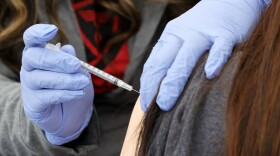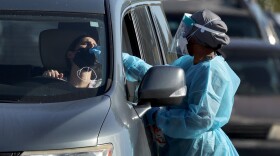The Centers for Disease Control and Prevention is not adding a testing requirement to its isolation guidelines for people infected with COVID-19 who want to end their isolation after five days.
Despite pressure from health experts who advocated adding a testing requirement, the agency is standing by its original guidance that a negative test is not needed for people who are fever-free and whose symptoms have improved.
Those who contracted the virus can end their isolation after five days while continuing to wear a well-fitting mask for an additional five days.
The CDC did include additional information for people who want to take a test before ending isolation, but they did not say people should get tested.
According to the CDC's updated guidance, the agency recommends that if an individual has access to a test and wants to test, the best approach would be to use an antigen test towards the end of their 5-day isolation period.
If the test result is positive, then an infected individual should continue to isolate until day 10, according to the CDC. If the test result is negative, officials said the person can end isolation, but continue to wear a well-fitting mask around others both at home and in public until day 10.
The agency also released a brief explanation of the science behind their decision, noting that studies suggested that a small percentage of people (between 25-30%) were self-isolating for a full 10 days.

"Although many people have intentions to self-isolate, both isolation and quarantine are challenging; especially in the context that many infections are asymptomatic," the CDC said.
Still, the agency stressed the importance of mask-wearing, as modeling data showed that around 30% of people remain infectious five days after receiving a positive test.
On Monday, the U.S. reported a record 1,082,549 new COVID-19 cases, according to data from Johns Hopkins University — with numbers that probably include cases from the holiday weekend.
The 7-day daily average for infections is hovering at nearly 500,000 per day.
Last week, the CDC shortened the number of days a person who tests positive for COVID should stay home, down from 10 days to 5 — followed by another 5 days of mask-wearing.
"The Omicron variant is spreading quickly and has the potential to impact all facets of our society," the CDC's director, Dr. Rochelle Walensky, said in a statement about the change. "CDC's updated recommendations for isolation and quarantine balance what we know about the spread of the virus and the protection provided by vaccination and booster doses. These updates ensure people can safely continue their daily lives."
News of the shortened isolation period prompted a backlash from public health experts, who urged the agency to require a negative rapid test to end isolation.
The Biden administration, which has come under pressure for not increasing the widespread availability of at-home tests, has rolled out a plan to set up federal testing across the country.
In addition, government officials say they will also buy a half-billion at-home COVID test kits and mail them out, with deliveries starting this month.
Copyright 2022 NPR. To see more, visit https://www.npr.org. 9(MDA3MzEzNjc2MDEzMDI2Mzc4OTc4NTFmNg001))












